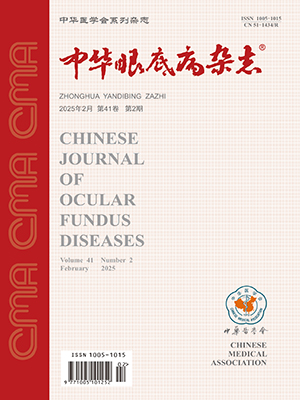| 1. |
Wessel MM, Aaker GD, Parlitsis G, et al. Ultra-wide-field angiography improves the detection and classification of diabetic retinopathy[J]. Retina, 2012, 32(4): 785-791. DOI: 10.1097/IAE.0b013e3182278b64.
|
| 2. |
Cai S, Liu TYA. The role of ultra-widefield fundus imaging and fluorescein angiography in diagnosis and treatment of diabetic retinopathy[J]. Curr Diab Rep, 2021, 21(9): 30. DOI: 10.1007/s11892-021-01398-0.
|
| 3. |
Ehlers JP, Jiang AC, Boss JD, et al. Quantitative ultra-widefield angiography and diabetic retinopathy severity: an assessment of panretinal leakage index, ischemic index and microaneurysm count[J]. Ophthalmology, 2019, 126(11): 1527-1532. DOI: 10.1016/j.ophtha.2019.05.034.
|
| 4. |
Jiang A, Srivastava S, Figueiredo N, et al. Repeatability of automated leakage quantification and microaneurysm identification utilising an analysis platform for ultra-widefield fluorescein angiography[J]. Br J Ophthalmol, 2020, 104(4): 500-503. DOI: 10.1136/bjophthalmol-2019-314416.
|
| 5. |
Jiang AC, Srivastava SK, Hu M, et al. Quantitative ultra-widefield angiographic features and associations with diabetic macular edema[J]. Ophthalmol Retina, 2020, 4(1): 49-56. DOI: 10.1016/j.oret.2019.08.008.
|
| 6. |
Aiello LP, Odia I, Glassman AR, et al. Comparison of early treatment diabetic retinopathy study standard 7-field imaging with ultrawide-field imaging for determining severity of diabetic retinopathy[J]. JAMA Ophthalmol, 2019, 137(1): 65-73. DOI: 10.1001/jamaophthalmol.2018.4982.
|
| 7. |
Solomon SD, Goldberg MF. ETDRS grading of diabetic retinopathy: still the gold standard?[J]. Ophthalmic Res, 2019, 62(4): 190-195. DOI: 10.1159/000501372.
|
| 8. |
Zhang Z, Ji Z, Chen Q, et al. Joint optimization of cycleGAN and CNN classifier for detection and localization of retinal pathologies on color fundus photographs[J]. IEEE J Biomed Health Inform, 2022, 26(1): 115-126. DOI: 10.1109/jbhi.2021.3092339.
|
| 9. |
Early Treatment Diabetic Retinopathy Study Research Group. Grading diabetic retinopathy from stereoscopic color fundus photographs-an extension of the modified airlie house classification: ETDRS report number 10[J]. Ophthalmology, 2020, 127(4): S99-S119. DOI: 10.1016/j.ophtha.2020.01.030.
|
| 10. |
Nicholson L, Vazquez-Alfageme C, Ramu J, et al. Validation of concentric rings method as a topographic measure of retinal nonperfusion in ultra-widefield fluorescein angiography[J]. Am J Ophthalmol, 2015, 160(6): 1217-1225. DOI: 10.1016/j.ajo.2015.09.003.
|
| 11. |
Ehlers JP, Wang K, Vasanji A, et al. Automated quantitative characterisation of retinal vascular leakage and microaneurysms in ultra-widefield fluorescein angiography[J]. Br J Ophthalmol, 2017, 101(6): 696-699. DOI: 10.1136/bjophthalmol-2016-310047.
|
| 12. |
Ding L, Bawany MH, Kuriyan AE, et al. A novel deep learning pipeline for retinal vessel detection in fluorescein angiography[J]. IEEE Trans Image Process, 2020, 29: 6561-6573. DOI: 10.1109/TIP.2020.2991530.
|
| 13. |
Pan X, Jin K, Cao J, et al. Multi-label classification of retinal lesions in diabetic retinopathy for automatic analysis of fundus fluorescein angiography based on deep learning[J]. Graefe's Arch Clin Exp Ophthalmol, 2020, 258(4): 779-785. DOI: 10.1007/s00417-019-04575-w.
|
| 14. |
Nunez do Rio JM, Sen P, Rasheed R, et al. Deep learning-based segmentation and quantification of retinal capillary non-perfusion on ultra-wide-field retinal fluorescein angiography[J/OL]. J Clin Med, 2020, 9(8): 2537[2020-08-06]. https://pubmed.ncbi.nlm.nih.gov/32781564/. DOI: 10.3390/jcm9082537.
|
| 15. |
Ye Y, Mao J, Liu L, et al. Automatic diagnosis of familial exudative vitreoretinopathy using a fusion neural network for wide-angle retinal images[J]. IEEE Access, 2020, 8: 162-173. DOI: 10.1109/ACCESS.2019.2961418.
|
| 16. |
Li Z, Guo C, Nie D, et al. Deep learning for detecting retinal detachment and discerning macular status using ultra-widefield fundus images[J]. Commun Biol, 2020, 3(1): 15. DOI: 10.1038/s42003-019-0730-x.
|
| 17. |
Schlegl T, Seeböck P, Waldstein SM, et al. f-AnoGAN: fast unsupervised anomaly detection with generative adversarial networks[J]. Med Image Anal, 2019, 54: 30-44. DOI: 10.1016/j.media.2019.01.010.
|
| 18. |
Siddiquee MMR, Zhou Z, Tajbakhsh N, et al. Learning fixed points in generative adversarial networks: from image-to-image translation to disease detection and localization[J]. Proc IEEE Int Conf Comput Vis, 2019, 2019: 191-200. DOI: 10.1109/iccv.2019.00028.
|
| 19. |
Zhang R, Tan S, Wang R, et al. Biomarker localization by combining CNN classifier and generative adversarial network[C/OL]//Medical Image Computing and Computer Assisted Intervention-MICCAI 2019, Shenzhen, 2019[2019-10-13]. https://doi.org/10.1007/978-3-030-32239-7_24).
|
| 20. |
Zhu JY, Park T, Isola P, et al. Unpaired image-to-image translation using cycle-consistent adversarial networks[C]. Proceedings of the IEEE International Conference on Computer Vision (ICCV), Venice, 2017: 2223-2232.
|




